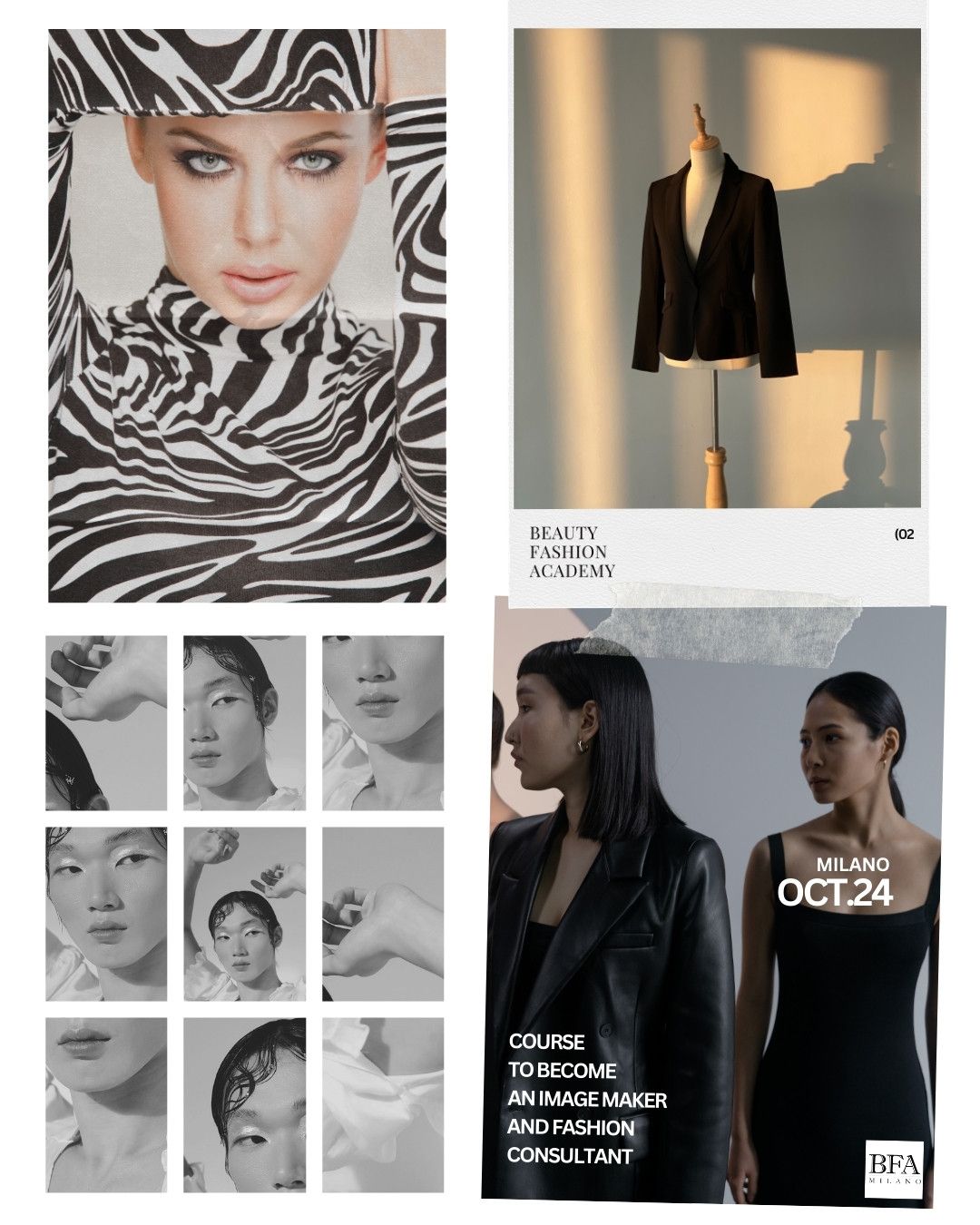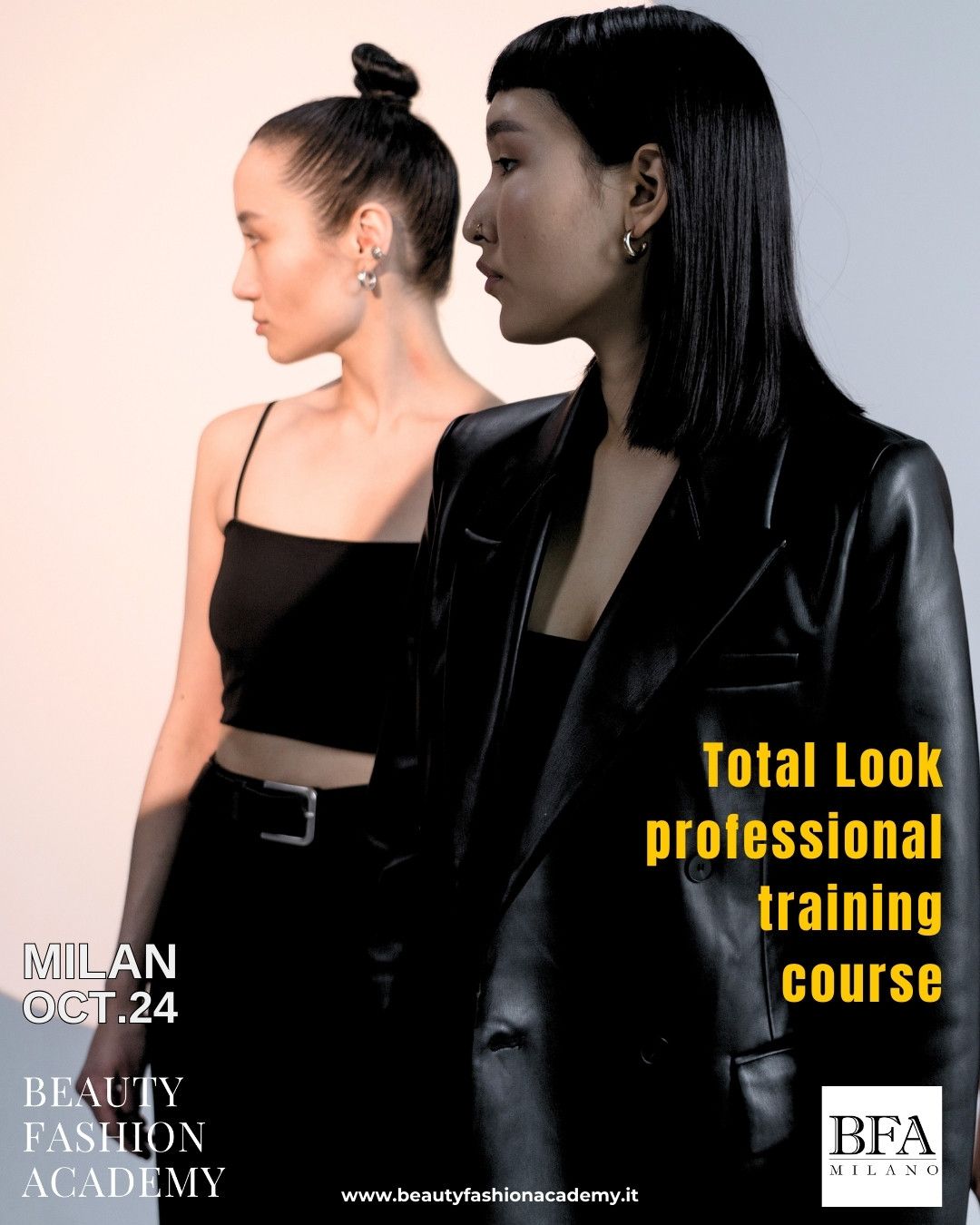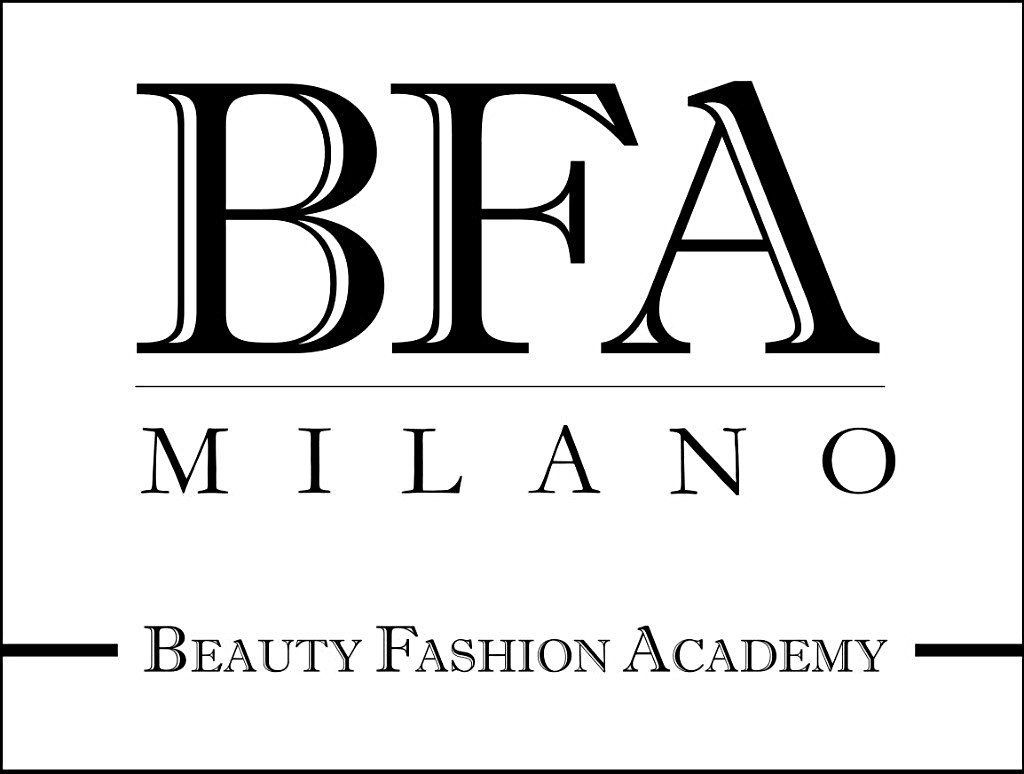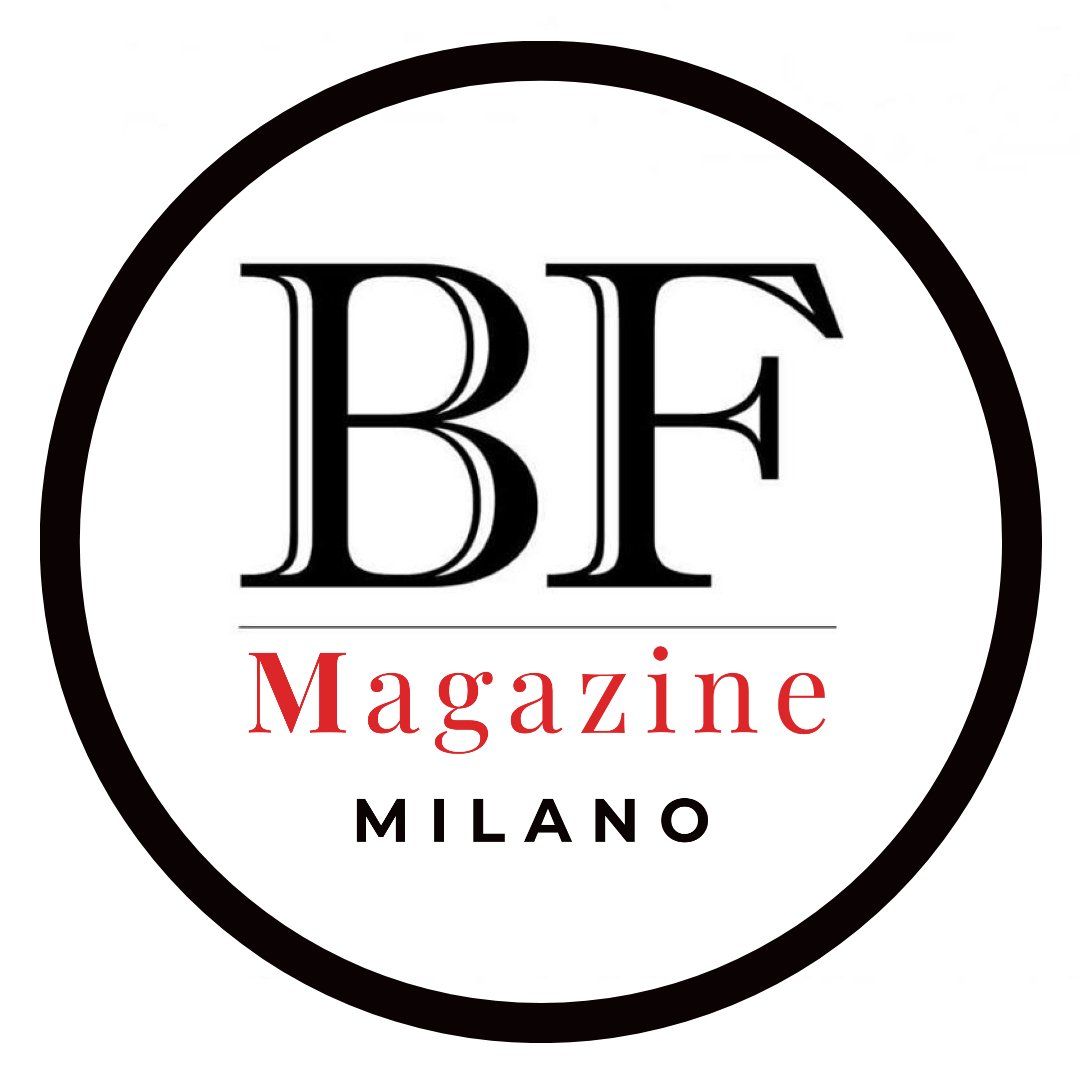BFA-MILANO uses the main and best-known textbooks relating to the topics covered in the lessons in its courses. Furthermore, further educational texts on Make-up, Fashion, History of Costume, Photography, Cosmetology, Communication, as well as all the most important reference magazines in the sector are always available to students, free of charge and upon reservation. In the lessons, both specific products for professional make-up and those best known on a commercial level are always used, including organic and vegan, for maximum teaching and training effectiveness based on the respective, specific characteristics that differentiate them (composition, INCI, performance, method of application, scope of use).

IMAGE DESIGN - PROFESSIONAL LOOK MAKING
Beyond the look, create an image. The path to becoming an Image Consultant starts here!

COURSE CONTENT
Elenco dei servizi
-
FASHION AND STYLE CONSULTING
- History of fashion and costume; historical notes
- Looks in the epochs from the 1920s to 2000
- Trend analysis
- Image analysis and style development
- Key points and elements for identifying, reinterpreting and configuring looks and dress codes based on the "style categories": classic, sporty, casual, classic, elegant, bon chic etc.
- Project and research look with specific identity based on the occasion (event, ceremony, etc.) and the style objective of the customer
- Mix and match: how to mix moods and garments to get new and original style ideas in a conscious and functional way
- The main trend setters today for current and up-to-date look proposals
- Creative styling for original and impactful looks
- Anticipating the future: the avant-garde vision and the reinterpretation of a garment
- Cult dresses and accessories from every era revisited and inserted in a contemporary look
- Jewelry and accessories: the combination of the elements of the look and the "must" colors relating to the image project
- Matching the various accessories/elements and between the accessory and the dress for perfect balance of the figure
- Effectively communicate the customer's personal aesthetics through the look
- Wedding style consulting: looks, models and accessories to achieve the style objective and for personalized interpretations
- The etiquette of style
- How to structure and develop an image project and the phases of a total look consulting process
What will you be able to do after this module?
You will be able to capture the essence of each individual, being able to select the perfect look for every occasion. You will acquire the ability to recognize and adapt unique styles and dresses based on the personality of the customer, the event and the nature of the ceremony.
Whether it is classic elegance or modern audacity, you will discover how to create perfect combinations, from elegant to boldly chic, always in perfect harmony, giving life to innovative and authentic styles. Finally, we will provide you with the tools to accompany your customers in the transformation of their style, designing image projects in line with their needs, values and aesthetics.
-
COLOR MODULE - COLOR THEORY and Chromatic ContrastsColor Theory and the Study of the Main Chromatic Circles The Wise and Strategic Use of Colors for the Total Look Chromatic Combinations The Psychology of Colors The Characteristics of Personal Colors Complementary and Analogous Colors The Correct Use of Complementary Colors in Makeup and Hairstyling Color Theory: Definitions, Historical Notes, and Differentiations of Analysis Types Compared How to Define a Season Based on the Skin/Eye/Hair Mix The 3 Fundamental Qualities of Colors Exploited in Color Harmony Intensity, Saturation, and Color Temperature: How to Transform the Starting Color of a Cosmetic Adapting It to the Type of Woman Recognizing the Seasons and Subgroups Through Step-by-Step Color Analysis Creating Completely Personalized Total Look Color Palettes Configuration of a Winning Color-Harmonic Look Even When It Is Not Possible (Due to Taste or the Customer's Choice) to Adopt Harmonizing Colors How to Proceed If the Customer Has Chosen a Dress or an Element of the Look That Is Not Flattering Color Theory in Makeup: Color Palettes and Chromatic Contrasts for the Various Seasons and Subgroups The Harmony of Color in Hairstyling: Guide to Choosing the Dye and the Application Methodology How and When to Use Chromatic Contrasts to Create Emphasis in an Effective and Winning Way What will you be able to do after this module? The laws of color and their nature will no longer be secrets to you. You will be able to exploit all chromatic relationships to create a flattering image both by contrast and by harmony. You will be able to identify a person's friendly and enemy colors through color analysis and perform the color analysis technically and professionally to identify the 4 SEASONS and the 16 SUBGROUPS, and associate them with the right color palette for the choice of dress, makeup, hair, and accessories. You will be able to create a personalized color chart that is differentiated from client to client, even if they belong to the same season, based on their unique and personal mix. You will also be able to break the rules in a conscious way and make flattering choices even by working in contrast and exploiting relationships to adapt a stylistic choice that is not flattering but a key point of the client's personality: because it is not only important what looks good, but what makes us feel good.
-
BODY SHAPES - Figure Analysis: Measurement and Study of Morphological ProportionsMoving lines: verticalization and horizontalization The shapes of the body: recognizing and identifying the various shapes Camouflage and camouflage techniques to harmonize the shape of the body The influence of fabrics and colors on shape Enhancement combination of prints and patterns Techniques to enhance the figure taking into account the client's physical characteristics and personality Solutions to the main problems concerning the figure Aesthetic and "corrective" combinations to hide defects and highlight advantages The influence of color and fabrics on shape Application of optical tricks to enhance and enhance the client's overall figure Positioning of accessories to streamline or create interruption in specific points What will you be able to do after this module? After this module, you will be able to: Recognize the types of patterns and fabrics of dresses and accessories and the optical effect they have on the figure. This will allow you to recommend the most suitable dress and combination for the body shape to enhance the figure as a whole. Perfectly distinguish the various body shapes and find the perfect flattering solution for each one. Interpret color in terms of shape to avoid attracting attention to unflattering points, even if the dress is right, and exploit all optical illusions in favor of overall visual harmony. Specifically, you will be able to: Identify the five main body shapes: triangle, rectangle, oval, hourglass, and apple. Understand the optical effects of lines, patterns, and fabrics on the figure. Use these principles to create flattering and stylish looks for clients of all shapes and sizes. This knowledge will be invaluable for anyone who wants to work in the fashion industry, as a personal stylist, or simply for their own personal style.
-
MAKE-UP/VISAGISMO/FACE SHAPES - Classical Proportions and Facial AnatomyVoce di elenco 1
- Diagnosis of Long and Wide Morphology and Targeted Intervention with Makeup and Accessories to Harmonize a Disharmonious Face
- Face shapes: How to recognize them and personalize the consultation on a case-by-case basis
- Elements of the face: The ratios and proportions of the nose, eyes, and lips, and the study of the modifications that can be made with makeup based on the client's needs
- How to balance and harmonize a face with optical illusions: Contouring and highlighting for various shapes
- How to shift the attention away from a less flattering element of a face and highlight the key points
- Skin tones, undertones, and overtones: A guide to choosing the right foundation
- Makeup and color: How to use complementary colors to neutralize dark circles and discoloration
- Types of makeup looks: From smokey eyes to cut-crease, from glow to wet look, and iconographic references for the correct configuration of the makeup look associated with styling
- Differences between natural makeup and nude makeup: Guiding the client towards conscious choices
- The visual impact of makeup based on the type of lighting and the seasons
- How to adapt the style of the makeup based on the client's personality and morphology
- Filters and photo editing: How to recognize what is real from what is not
- Ethics of aesthetics: How to handle look requests resulting from web/social proposals that sell the dream of an "impossible beauty"
- Recommended accessories (shape and color) based on the client's morphological and chromatic type
- Visual research for beauty proposals, and the main channels that can be exploited
- Preparation of proposed Face Chart/Professional Makeup Chart
What will you be able to do after this module?
After this module, you will be able to:
Identify the key points of a face and modify the parameters to create new harmonies by modifying the elements.
Configure a makeup look in line with the dress code and with the morphological and identity characteristics of the client for everyday life, on a special occasion/event.
Specifically, you will be able to:
Diagnose the morphological and chromatic type of the client.
Identify the key points of the face and the areas that need to be balanced or harmonized.
Use makeup techniques, such as contouring, highlighting, and color, to create a more harmonious and flattering appearance.
Choose the right makeup products and colors for the client's skin tone, hair color, and eye color.
Create a makeup look that is appropriate for the occasion or event.
-
HAIR STYLING - The Design of the "Face Frame"Voce di elenco 2History of hair style and hairstyle: social marker dependent on fashion, place and context Hair man, beard and mustache Hair & Face shapes: cuts, folds and hairstyles based on the shape of the face The influence of air on the entire figure: how to make the overall image slimmer or shorter by choosing the right hair Correction or accentuation of facial morphology with hairstyling Types of hairstyles based on style and occasion Types of crops and diversification of choice based on the final image project Most requested folds and updos Hair combined with headgear and accessories Hair styling and types of veil The looks with loose hair Management of the type of hairstyle based on the change of look How to make an image harmonious if the client has a non-flattering hair color and doesn't want to change it Visual search for Beauty/Fashion proposals, and the main exploitable channels Types of hairstyling based on the type of event and climatic condition Hair&MakeUp report for a winning facial image project. Recommended hair accessories (shape and color) based on the customer's morphological and chromatic type Visual search for beauty proposals, and the main exploitable channels. Preparation of professional look proposal Cut/color consultancy simulation What will you be able to do after this module? You will be able to consciously answer the questions "what color/cut/hairstyle do you recommend?" Evolving the advice into "professional consultancy" starting from the identification of a hair look up to reinterpreting it in a modern key based on the style and mood of the event/ceremony or for everyday life. You will be able to create truly applicable references based on the texture, thickness and natural bend of the hair and match the right hairstyle to the accessory and vice versa, all perfectly in line with the makeup up and style look. You will learn to modify the contour of the face and to camouflage the weak, unbalanced or too protruding or recessed points of a face through the choice of the perfect styling, always in line with the tastes and personality of your client. You will also learn the use of apps and temporary application techniques to let your client preview the solution designed before making the final choice, and create a professional mood board useful for specialized operators to remain faithful to your image project
-
NAILS - Styled hands and feetVoce di elenco 4
- Hand/Foot Beauty: the various temporary or permanent solutions recommended based on the morphology of the nail and the occasion
- The image of hands and feet based on the focus of the look
- Jewel nails
- Hand-feet-wrist-ankle accessories
- Anatomy and types of nail shape
- Nails shapes based on the morphology of the hand
- Manicure and the main nail trends in eras adapted to the contemporary
- Chromatic and harmonious matching of the enamel
- Extreme nail concept
- Visual search for beauty/fashion proposals, and the main exploitable channels.
- Moodboard research and hand/look proposal in relation to styling
- Bridal Nails Trend
What will you be able to do after this module??
You will be able to advise your client on the type of intervention most suited to the type of occasion and budget and configure the type of nail art best suited to the general styling and type of nail bed. You will learn the differences between the various reconstruction and lengthening treatments, both long-lasting and extemporaneous, and identify the most suitable form based on the type of hand and the morphology of the fingers. You will also be able to adapt the most suitable jewels and always in line with the manicure and in the case of the spouse, learn the symbolism of the specific positioning of the jewels based on where they are applied to be a reference of both style and etiquette.
-
PHOTOGRAPHY/VIDEO - Photography notions, from lighting to types of cropping and shooting toolsVoce di elenco 3
- Lighting schemes to enhance the total body and beauty
- Composition - rule of thirds and foundations of composition
- Differences between studio and outdoor
- Shooting techniques to portray your work effectively and successfully even with a simple smartphone
- How to correctly photograph/film the client to create effective storytelling in the various phases of the consultancy
- How to organize the station for autonomous photo/video shooting
- Shooting, cropping and editing modes to create functional videos
- Types of backdrops and panels that can be used
- Set design: Set configuration
- Management of lights and panels for the configuration of a functional "do-it-yourself" set within your studio/salon/shop
- The influence of light on colors in terms of intensity and temperature
- Client management: making her feel comfortable during shots/video recordings
- Notions of photographic retouching and editing with professional apps and programs
- Selection criterion and choice of shots based on the destination/objective of the communication depending on the dissemination platform
- Privacy and Copyright, how to protect your work
What will you be able to do after this module?
You will be able to use the shooting devices in full autonomy and in a more conscious and professional manner to better describe your work and/or the journey of a client, and independently take photos and videos for your web/social communications or for the customer card. You will also be able to create a storyboard to guide the graphics and web professionals who will support your work and who will support you in photo shoots.
-
VISUAL COMMUNICATION & Marketing - Current visual communication specific to the Fashion and Beauty sectorsCreate emotions and tell stories through the creation of images/videos designed "ad hoc" The diversification of the service dissemination strategy based on the platforms Diversification and creation of audience targets Story telling Successful case histories Visual communication on the web and in social networks How to leverage current channels to promote your service The reference professionals in the communication sector What will you be able to do after this module? You will discover how to exploit the algorithm system to your advantage and diversify communication and campaign/promotion choices based on the platform. You will understand how to organize the work to create stories through visual communication that will attract your target audience to your services, and you will be able to create an effective editorial plan for publishing content with little effort. You will also be able to manage a sector professional more consciously to avoid wasting time and money without having an influx of customers into the salon.
COURSE SHEET

THE COURSE INCLUDES:
● Class academic TEACHING KIT
● PERSONAL EDUCATIONAL KIT including:
- technical material useful for carrying out chromatic and morphological analyses
- color identification and cataloging cards
- customized color kit
- morphology analysis kit for make-up/hair styling
- customizable moodboard templates for creating image projects
- access to professional post-production and photo editing programs/apps
- access to post graphics programs/apps and project layout
- History of fashion and costume manual
● Personal USB KEY with teaching notes and technical material
● LESSONS and practical exercises in the classroom and outdoors
● FASHION SET Experience
● WORK EXPERIENCE
● Free access and use of textbooks on Fashion, Photography, Make-Up, Costume, Cosmetology
● Professional Photographic SHOOTING
● Consumables
● TUTORING
and professional assistance for one year

AT THE END OF THE COURSE, THE FOLLOWING ARE RELEASED:
● CERTIFICATE
of attendance and professional specialization certification
Image Designer / Fashion Consultant
● PHOTO BOOK of individual and group projects created in the course
● PROFESSIONAL PHOTO PORTFOLIO with selected photos complete with post-production
● COLOR analysis kit
● MORPHOLOGY analysis kit
● MANUAL of Fashion and Costume History
● Personal USB key with Teaching Materials, Technical Material
● 30% discount card for purchase/restocking of material for one year
● PRIORITY ACCESS card with reserved discounts for one year for additional optional training/specialization courses
START CLASSROOM: OCTOBER, 28
START ONE-TO-ONE: from JUNE, JULY or SEPTEMBER
TOTAL DURATION 35 Lessons
Practical lessons, demos and design in the classroom + Theoretical lessons in the classroom + Work experience + Post-course tutoring
FREQUENCY
CLASSROOM: from Monday to Thursday - 6 hours per lesson / 210 hours in total - Start from 10.28
INDIVIDUAL: from 2 to 5 days per week - Start from May, June or Sept.
TIMETABLES
10:00am - 1:00pm / 2:00pm - 5:00pm
COST OF THE COURSE
CLASSROOM: €,7.500.00 all inclusive including VAT
(down payment €1,000.00 - balance €6,500.00)
INDIVIDUAL WITH CUSTOMIZED DATES AND FREQUENCY: €,9.000.00 all inclusive including VAT
(down payment €1,000.00 - balance €8,000.00)
The cost of the course can be paid in three instalments,
net of the registration fee.
CLOSED NUMBER COURSE - MAXIMUM 10 STUDENTS per class
The Academy reserves the right to request an interview prior to enrolling in the Course.
Registrations will close when the maximum number of students expected is reached.
The cost indicated is all-inclusive, there are no additional costs for registration, exam or purchase of extra products.
The course is also available in individual form (for individuals, groups of students or companies)
with start date, frequency and end of lessons fully customizable.

COURSE REGISTRATION
It is possible to enroll directly online by clicking the button and filling out the appropriate form, making a down payment of €1.000.00 payable by bank transfer using the indicated coordinates, or online with Credit Card/PayPal.
The balance can be paid before the start of classes or can be split into installments in a personalized way, with a deadline in any case by the end of the Course.
OPTIONAL SUPPLEMENTARY TRAINING COURSES
At the end of the Course, students who wish to further integrate their technical background or wish to specialize in a specific professional sector will be able to access specific supplementary packages to be carried out individually and educationally designed to be an ideal complement to what has already been learned, or to Training Courses. o Specialization to train professional profiles ready for subsequent entry into the world of work. Access to courses and supplementary packages provides highly discounted and exclusive conditions thanks to the personal Membership Card issued with the certificate.

CONTATTI e INFO
info@beautyfashionacademy.it +390282874595 / +393791397891















